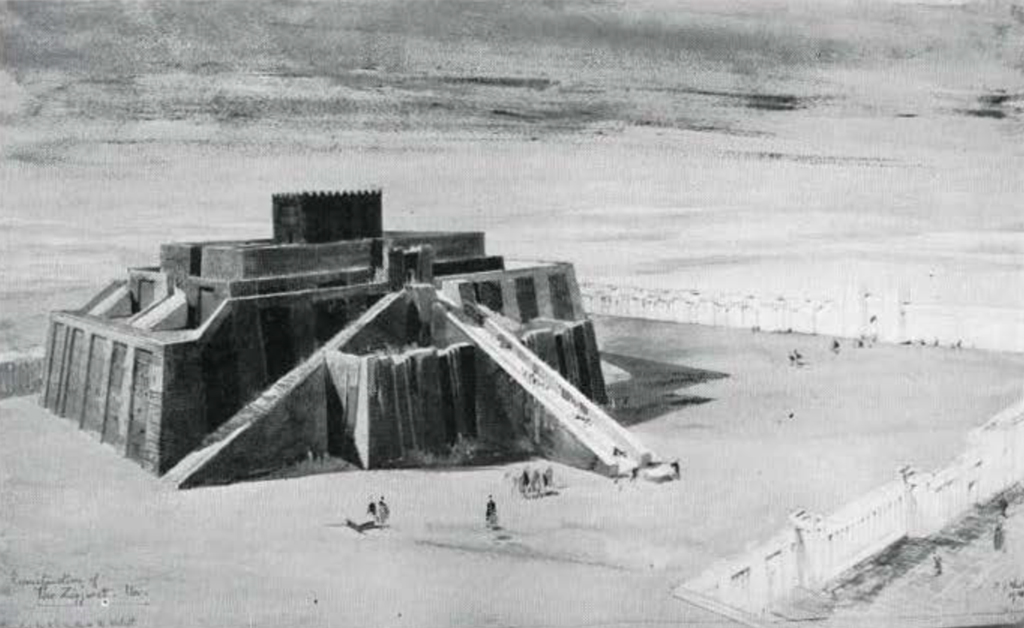Such is the picture of the first establishment of the Sumerians in southern Mesopotamia as revealed by the German excavations at Uruk (Warka) when resumed in 1928 under the direction of Dr. Julius Jordan. This venerable city (the Erech of the Bible), fifty miles northwest of Ur, has a long history. It was the second royal city after the Deluge, where ruled Gilgamesh, the legendary hero of the national epic. It was still a great centre of learning at the end of the first millennium, under King Antiochus IV (175-64 B.C.) when the temples of Anu and Antum were rebuilt by the local governor. Close by, the massive mud brick tower of Eanna still stands over thirty-six metres high. It is a construction of King Ur-Nammu of the Third Ur Dynasty (2120 B.C.) to Innina-Ishtar, the goddess of Uruk. In the following centuries it was in turn restored by the Cassite, Babylonian and Assyrian kings. While the graves of al-‘Ubaid had been early forgotten and its painted pottery was almost exposed on the surface of the desert, in the ruins of larger cities like Uruk, Ur, Kish, Nippur, Fara, Adab, they were buried below the accumulated debris left by successive generations of town dwellers, from the original Sumerian or pre-Sumerian down to the Greek, Parthian and even Arab periods of occupation. An artificial hill was thus formed, in certain cases more than sixty feet over the virgin soil, and the early levels could be reached only by deep pits and trenches exposing the various layers in historic sequence. Such has been the common practice of most of the expeditions sent to southern Mesopotamia in the last twenty years. The result has been the revelation of another millennium of early history after and even before a great Deluge of which traces have been found at Ur and at Kish.

Image Number: 162199
A deep trench was opened in 1929 at Uruk in the court of Eanna, at the foot of the brick tower, down to the archaic level, and as the work progressed in the following years, it revealed a new and fascinating aspect of the Sumerian culture in what is now called the Uruk period. Its most impressive feature is the brick tower rising, mountain-like, in receding stages towards heaven, and crowned, as we shall see, by a small shrine. Such towers still distinguish most of the Mesopotamian ruins. The tower of Babel-which has been entirely destroyed-owes its fame to Biblical tradition. The tower itself was only a part of the temple. It was built on an artificial brick platform, surrounded by a strong wall, leaving room for open courts and shrines. Staircases led to the upper stages, a large gate to an outer court. The three temples of Ur, Uruk and Nippur, and their towers, were constructed on the same plan by King Ur-Nammu (Figure 27). One angle of the rectangular tower points east. Three staircases are disposed along the northeast face, one right, one left, one in the middle-of one hundred steps each at Ur. Between the stairs, on the platform, small shrines were dedicated to the local god and goddess; other shrines against the walls were devoted to minor deities. The core of the tower was of mud bricks, the outer walls of baked bricks, stamped with the name of the builder and inlaid in bitumen. The retaining walls had an inward batter to resist the pressure of the massive core, and were decorated with recessed panels. Vertical drains northwest and southeast disposed of the rain water. There were probably three stages, the last supporting the heavenly house of the god-a very ancient Sumerian feature. Stamped bricks record the names of many restorers down to the Seleucids. Alexander died before he could rebuild the tower of Babylon. Nabonidus completed at Ur the work of Ur-Nammu. His blue glazed bricks, stamped with his name, may be seen in the University Museum; they were destined for the little shrine at the top. With them are on view the small clay cylinders which he buried at the four corners of the second stage. On them is inscribed his memorial of the good work and a prayer to the moon god for himself and for his son Belshazzar (Daniel II: 26).
The progress of excavations at Uruk shows that the monumental towers of Ur-Nammu were only an enlarged edition of much older religious and architectural tradition. Trenches opened from the Ur- Nammu period down to archaic levels or cut into the mud core of the tower, have revealed a succession of building periods. They are characterized by new types of bricks, the piano-convex and the small flat riemchen; by inscribed archaic tablets and seal impressions; by mosaic decoration made of clay cones and plaques, and finally, in the Uruk period proper, by the remains of two shrines, the “Red Temple” which is decorated with vertical recesses, and a still older “temple” resting on limestone foundations. The pictographic tablets, the cylinder seals and the flat seals in the same level are the first record of the new Sumerian culture, associated with mud towers, erected on mud platforms, decorated around the edges and the top with elaborate mosaic work. Ur-Nammu’s reconstruction and enlargement have buried and covered the small primitive tower. But, as luck would have it, his own tower decayed in time, and through the packing of later additions the summit of the older one is now visible, and with it the perfect plan of a miniature shrine which crowned it in the Uruk period. It is called the “White Temple” from the white plaster which still bedaubed its walls and served to trace courts, doors and recesses. It is tentatively dated at 3000 B.C., at the beginning of the Uruk period. At the bottom of the great shaft, down to the virgin soil, fragments only of the al-‘Ubaid painted pottery were found in increasing number.

